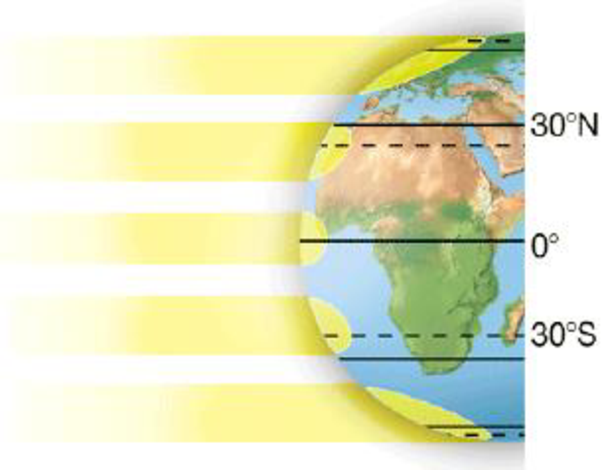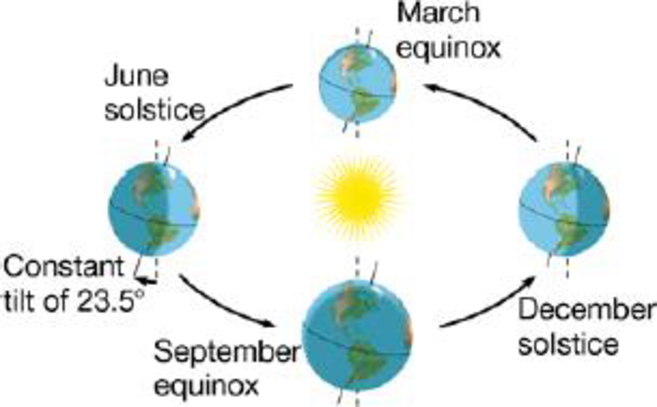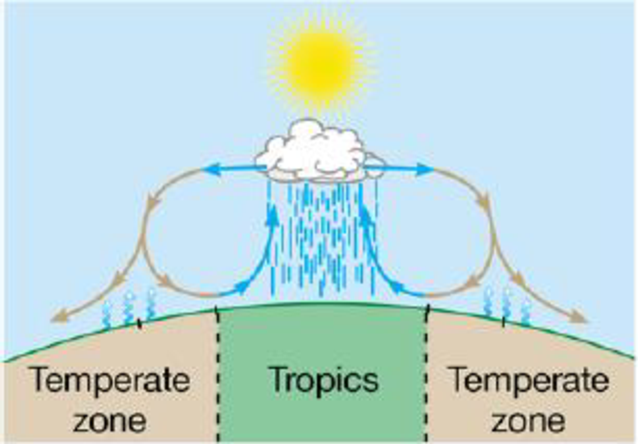
Concept explainers
You have seen that Earth’s terrestrial biomes reflect regional variations in climate. But what determines these climatic variations? Interpret the following diagrams in reference to how each represents effects on global patterns of temperature, rainfall, and winds.
a. Solar radiation and latitude:

b. Earth’s orbit around the sun:

c. Global patterns of air circulation and rainfall:

(a)
To determine: Solar radiation and latitude representing the effects on global pattern of temperature, rainfall and wind and also the climatic variations.
Introduction:
Biomes are the regions with similar climate and terrestrial biome distribution is decided by rainfall and temperature. The terrestrial biomes are tundra, rainforest, desert, taiga, temperate forest, alpine and savanna.
Explanation of Solution
The solar radiation amount received by earth is depends upon the location of the biome. The amount of received sunlight will be high if the biome is located at equator, resulting in hot conditions in biome. At the poles, biomes are cold due to the availability of less sunlight.
(b)
To determine: Earth’s orbit around the sun representing the effects on global pattern of temperature, rainfall and wind and also the climatic variations.
Introduction:
Biomes are the regions with similar climate and terrestrial biome distribution is decided by rainfall and temperature. The terrestrial biomes are tundra, rainforest, desert, taiga, temperate forest, alpine and savanna.
Explanation of Solution
Different seasons are the result of earth rotation, because both hemisphere experience opposite season due to tilt of earth on its own axis.
The tilt of the northern hemisphere of earth towards the sun results in summer as the tilt allows entry of more sunlight and summer in the northern hemisphere means winter in the southern hemisphere because it is away from the sun so receives less sunlight.
(c)
To determine: Global pattern of air circulation and rainfall representing the effects on global pattern of temperature, rainfall and wind and also the climatic variations.
Introduction:
Biomes are the regions with similar climate and terrestrial biome distribution is decided by rainfall and temperature. The terrestrial biomes are tundra, rainforest, desert, taiga, temperate forest, alpine and savanna.
Explanation of Solution
Extreme sunlight at equators results in evaporation of water from the land and oceans, which cools and condenses, converting into rain. For example: tropical rainforests.
At 30 degree latitude of south and north, the circulating air warms as it fals causing evaporation of moisture present in the soil, leading to dryness (arid regions in the temperate zones). For example: deserts.
Want to see more full solutions like this?
Chapter 34 Solutions
CAMPBEL BIOLOGY:CONCEPTS & CONNECTIONS
- In Drosophila, an X linked recessive mutation, scalloped (sd), causes irregular wing margins. Diagram the F1 and F2 results if a (a) scalloped female is crossed with a normal male; (b) a scalloped male is crossed with a normal female (assume the female is homozygous). Compare these results to what you would find if the trait was not sex linked.arrow_forwardCase Study—Ella Ella has a family history of diabetes. She wants to follow a healthful eating pattern that can lower her risk for developing this condition. Her dietitian recommends a goal of 450 to 600 kcal per meal and advises Ella to follow the Acceptable Macronutrient Distribution Range (AMDR) for carbohydrates and the Dietary Guidelines for Americans 2015-2020, which recommend limiting added sugar. She also recommends that Ella choose whole grains rather than processed grains. Ella decides to pack a lunch to take to work every day. This morning she’s making a sandwich for her lunch. Categories of Sandwich Options (Top of the screen) Breads Spreads Cheeses Vegetables Proteins Specific food items to select White Bread 6-inches Honey Mustard Provolone LettuceTomatoBell Peppers Turkey Part A - Reading Nutrition Facts Panels for Total Kilocalories How many total kilocalories are in Ella’s sandwich exactl ______kcal ? Part B - Reading Nutrition Facts Panels for…arrow_forwardC MasteringHealth MasteringNu × session.healthandnutrition-mastering.pearson.com/myct/itemView?assignment ProblemID=17465255&attemptNo=1&offset=prevarrow_forwardBiopharmaceutics and Pharmacokinetics:Two-Compartment Model Instant Absorption Questions SHOW ALL WORK, including equation used, variables used and each step to your solution, report your regression lines and axes names (with units if appropriate) :Calculate a-q a) B1, b) B2, c) hybrid rate constant (1) d) hybrid rate constant (2) e) t1/2,dist f) t1/2,elim g) k10 h) k12 i) k21 j) initial concentration (C0) k) central compartment volume (V1) l) steady-state volume (Vss) m) clearance (CL) AUC (0→10 min) using trapezoidal rule n) AUC (20→30 min) using trapezoidal rule o) AUCtail (AUC360→∞) p) total AUC (using short cut method) q) volume from AUC (VAUC)arrow_forwardGlitazones reduce insulin resistance by binding to a transcription factor in adipocytes, thereby reducing thesecretion of fatty acids. Glitazones are taken orally (in pill form). Using pharmacokinetic modeling, deriveequations to describe how the concentration of glitazones varies in the plasma as a function of time. Yourequations should be of the form: dCglitazone /dt = something, or dMglitazone /dt = something. Your model shouldinclude three compartments: the gut, the plasma, and the fatty tissues. Make sure to include a diagram thatillustrates your thinking, state all assumptions, and define your variables. Do not solve the equations.arrow_forwardCase Study—Ella Review the case study and then answer Parts A through F. Ella has a family history of diabetes. She wants to follow a healthful eating pattern that can lower her risk for developing this condition. Her dietitian recommends a goal of 450 to 600 kcal per meal and advises Ella to follow the Acceptable Macronutrient Distribution Range (AMDR) for carbohydrates and the Dietary Guidelines for Americans 2015-2020, which recommend limiting added sugar. She also recommends that Ella choose whole grains rather than processed grains. Ella decides to pack a lunch to take to work every day. This morning she’s making a sandwich for her lunch. Categories of Sandwich Options (Top of the screen) Breads Spreads Cheeses Vegetables Proteins Specific food items to select White Bread 6-inches Honey Mustard Provolone LettuceTomatoBell Peppers Turkey Part A - Reading Nutrition Facts Panels for Total Kilocalories How many total kilocalories are in Ella’s sandwich? _____…arrow_forward, if one of the archaeological specimens lacked the celiac disease-causing epitope, how could PCR be used to identify the allele in a contemporary germplasm collection of wild wheats, and to assist in transferring the allele to modern wheat varieties?arrow_forwardNow you will consider the composition of lipoproteins, including where they are synthesized, how they circulate, and where the various lipid and protein components are located within the lipoprotein molecule. Drag the appropriate labels to their respective targets.arrow_forwardThe Oregon Wolfe Barley mapping population is unique in having 12 easily-scored morphological markers, each showing monogenic inheritance. Do you consider these markers useful? Briefly defend your answer, pointing out advantages and disadvantages of morphological vs. molecular markers.arrow_forwardBiopharmaceutics and Pharmacokinetics:Two-Compartment Model Instant Absorption Questions Calculate these : a) B1, b) B2, c) hybrid rate constant (1) d) hybrid rate constant (2) e) t1/2,dist f) t1/2,elim g) k10 h) k12 i) k21 j) initial concentration (C0) k) central compartment volume (V1) l) steady-state volume (Vss) m) clearance (CL) AUC (0→10 min) using trapezoidal rule n) AUC (20→30 min) using trapezoidal rule o) AUCtail (AUC360→∞) p) total AUC (using short cut method) q) volume from AUC (VAUC)arrow_forwardIn a population of Jackalopes (pictured below), horn length will vary between 0.5 and 2 feet, with the mean length somewhere around 1.05 feet. You pick Jackalopes that have horn lengths around 1.75 feet to breed as this appears to be the optimal length for battling other Jackalopes for food. After a round of breeding, you measure the offsprings' mean horn length is 1.67. What is the heritability of horns length (h2)? Is Jackalope horn length a heritable trait? (4 pts)? 12pt v R Paragraph V BIU A श्र > Barrow_forwardThere are many differences between DNA replication happening during mitosis in a Douglas fir tree growing in the Oregon Cascade Mountains and DNA replication happening during a PCR reaction in a forestry research lab at Oregon State University where the laboratory is amplifying a Simple Sequence Repeat. Complete the following table that compares the two DNA replication events in terms of the primers, the nucleotides, the polymerase, and the target sequence. Additionally, give a general value for the number of copies of the template DNA after one S phase in one cell and after the lab has completed the PCR reaction. Tree SSR Type your answer here: Primers Nucleotides Polymerase Target sequence Number of copiesarrow_forwardarrow_back_iosSEE MORE QUESTIONSarrow_forward_ios
 Biology (MindTap Course List)BiologyISBN:9781337392938Author:Eldra Solomon, Charles Martin, Diana W. Martin, Linda R. BergPublisher:Cengage Learning
Biology (MindTap Course List)BiologyISBN:9781337392938Author:Eldra Solomon, Charles Martin, Diana W. Martin, Linda R. BergPublisher:Cengage Learning Concepts of BiologyBiologyISBN:9781938168116Author:Samantha Fowler, Rebecca Roush, James WisePublisher:OpenStax College
Concepts of BiologyBiologyISBN:9781938168116Author:Samantha Fowler, Rebecca Roush, James WisePublisher:OpenStax College Biology: The Dynamic Science (MindTap Course List)BiologyISBN:9781305389892Author:Peter J. Russell, Paul E. Hertz, Beverly McMillanPublisher:Cengage Learning
Biology: The Dynamic Science (MindTap Course List)BiologyISBN:9781305389892Author:Peter J. Russell, Paul E. Hertz, Beverly McMillanPublisher:Cengage Learning Human Biology (MindTap Course List)BiologyISBN:9781305112100Author:Cecie Starr, Beverly McMillanPublisher:Cengage Learning
Human Biology (MindTap Course List)BiologyISBN:9781305112100Author:Cecie Starr, Beverly McMillanPublisher:Cengage Learning
 Biology 2eBiologyISBN:9781947172517Author:Matthew Douglas, Jung Choi, Mary Ann ClarkPublisher:OpenStax
Biology 2eBiologyISBN:9781947172517Author:Matthew Douglas, Jung Choi, Mary Ann ClarkPublisher:OpenStax





